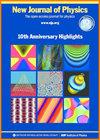光子识别器:接近射出噪声极限的自适应量子光学传感
IF 2.8
2区 物理与天体物理
Q2 PHYSICS, MULTIDISCIPLINARY
引用次数: 0
摘要
光场的光子统计可用于低光照度情况下的量子光学传感,而无需笨重的光学元件。然而,通过光子数量分辨检测来揭示光子统计具有挑战性。在这里,我们提出了一种新颖的检测方法,我们称之为 "光子辨别",它使用自适应光子阈值进行光子统计估算,而无需记录精确的光子数。我们的光子辨别器受到神经网络领域的启发,在该领域中,可调阈值已被证明能有效地提取机器学习任务中的信息。光子辨别器通过实时迭代选择最佳阈值来最大化每个光子的费雪信息,从而接近拍摄噪声极限。我们提出的自适应光子阈值方案带来了独特的量子度线性偏振相机和量子激光雷达遥感应用。我们对最佳阈值进行了研究,结果表明,由于光子束效应,即使对于弱信号(平均光子数远小于 1),最佳光子阈值也可能是反直觉的(不等于 1)。我们还提出了一种实现光子辨别器的超导纳米线,可以在短期内通过实验实现。我们的研究表明,我们的光子辨别器的适应性使其能够在某些应用中击败光子数分辨率有限的现实光子数分辨探测器。我们的工作为信息论驱动的、紧凑的和基于学习的量子光学传感提出了一类新的探测器。本文章由计算机程序翻译,如有差异,请以英文原文为准。
Photon discerner: adaptive quantum optical sensing near the shot noise limit
Photon statistics of an optical field can be used for quantum optical sensing in low light level scenarios free of bulky optical components. However, photon-number-resolving detection to unravel the photon statistics is challenging. Here, we propose a novel detection approach, that we call ‘photon discerning’, which uses adaptive photon thresholding for photon statistical estimation without recording exact photon numbers. Our photon discerner is motivated by the field of neural networks where tunable thresholds have proven efficient for information extraction in machine learning tasks. The photon discerner maximizes Fisher information per photon by iteratively choosing the optimal threshold in real-time to approach the shot noise limit. Our proposed scheme of adaptive photon thresholding leads to unique remote-sensing applications of quantum degree of linear polarization camera and quantum LiDAR. We investigate optimal thresholds and show that the optimal photon threshold can be counter-intuitive (not equal to 1) even for weak signals (mean photon number much less than 1), due to the photon bunching effect. We also put forth a superconducting nanowire realization of the photon discerner which can be experimentally implemented in the near-term. We show that the adaptivity of our photon discerner enables it to beat realistic photon-number-resolving detectors with limited photon-number resolution in certain applications. Our work suggests a new class of detectors for information-theory driven, compact, and learning-based quantum optical sensing.
求助全文
通过发布文献求助,成功后即可免费获取论文全文。
去求助
来源期刊

New Journal of Physics
物理-物理:综合
CiteScore
6.20
自引率
3.00%
发文量
504
审稿时长
3.1 months
期刊介绍:
New Journal of Physics publishes across the whole of physics, encompassing pure, applied, theoretical and experimental research, as well as interdisciplinary topics where physics forms the central theme. All content is permanently free to read and the journal is funded by an article publication charge.
 求助内容:
求助内容: 应助结果提醒方式:
应助结果提醒方式:


